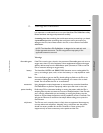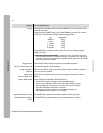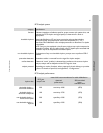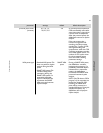
37
Philips Medical Systems
APPENDICES
ECG analysis system
ECG analysis performance
category specifications
function Evaluates impedance of adhesive pads for proper contact with patient skin, and
evaluates the ECG rhythm and signal quality to determine if a shock is
appropriate.
shockable rhythms Ventricular fibrillation (VF) and some ventricular tachycardias, including
ventricular flutter and polymorphic ventricular tachycardia (VT). The
HeartStart FRx Defibrillator uses multiple parameters to determine if a rhythm
is shockable.
NOTE: Some very low-amplitude or low-frequency rhythms may not be interpreted as
shockable VF rhythms. Also, for safety reasons, some VT rhythms often associated with
circulation may not be interpreted as shockable rhythms.
non-shockable rhythms On detection of any non-shockable rhythm, prompts user to perform CPR if
needed.
pacemaker detection Pacemaker artifact is removed from the signal for rhythm analysis.
artifact detection If electrical “noise” (artifact) is detected that interferes with accurate rhythm
analysis, analysis will be delayed until the ECG signal is clean.
analysis protocol Depending on results of analysis, either prepares for shock delivery or provides
a pause. For details of protocol, see Appendix F, “Configuration.”
rhythm class
ECG test
sample
a
size
meets AHA recommendations
b
for adult defibrillation
observed 90% one-sided
performance lower
confidence limit
shockable rhythm —
ventricular fibrillation
300 sensitivity >90% (87%)
shockable rhythm —
ventricular tachycardia
100 sensitivity >75% (67%)
non-shockable rhythm —
normal sinus rhythm
300 specificity >99% (97%)
non-shockable rhythm —
asystole
100 specificity >95% (92%)


















